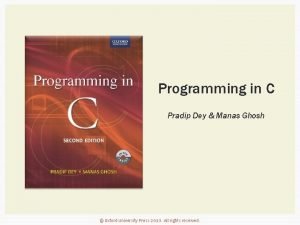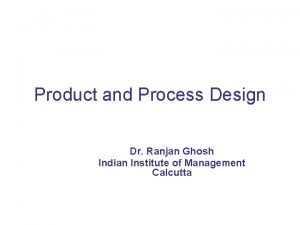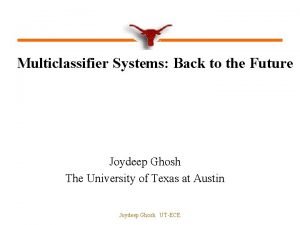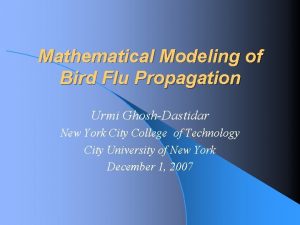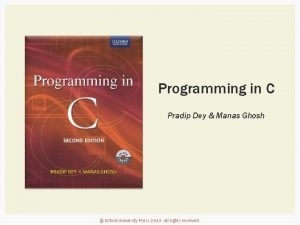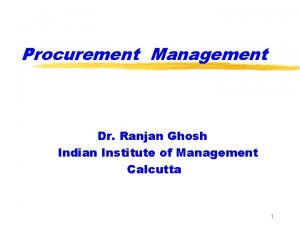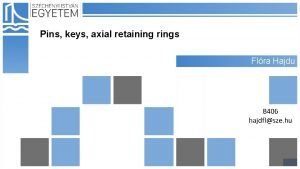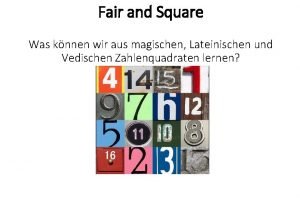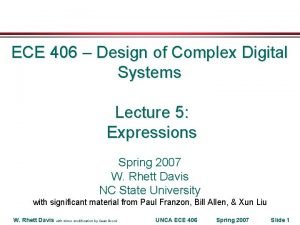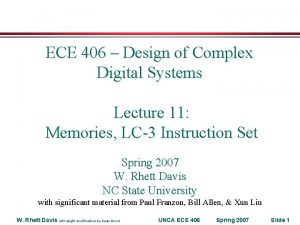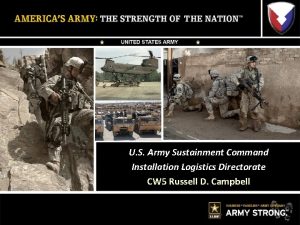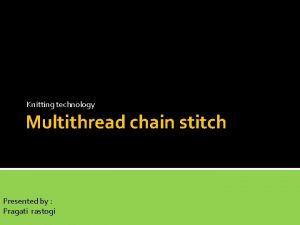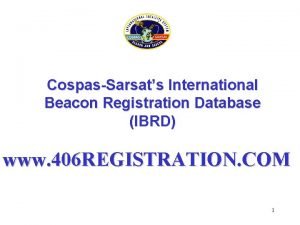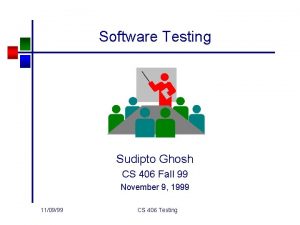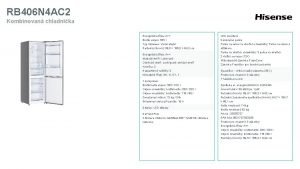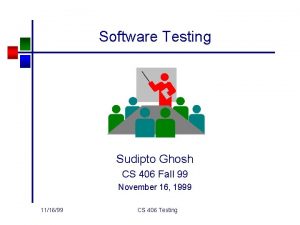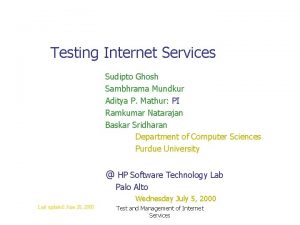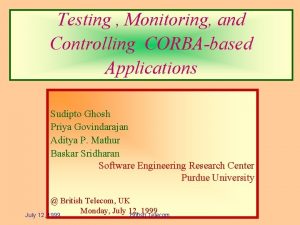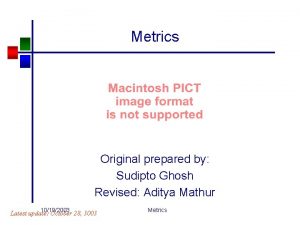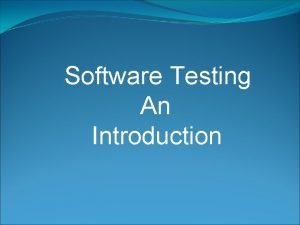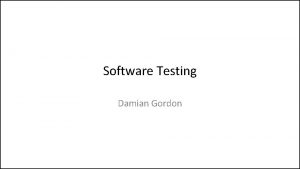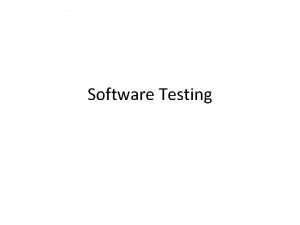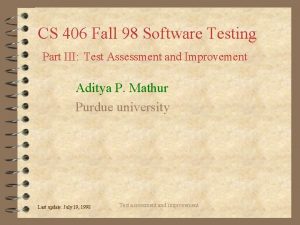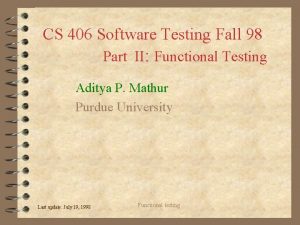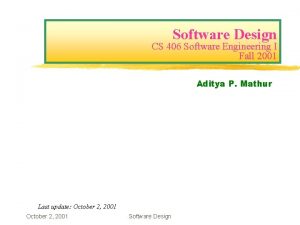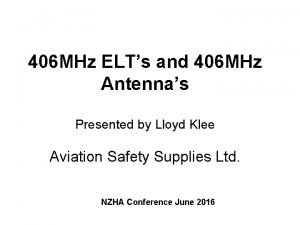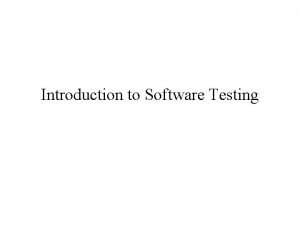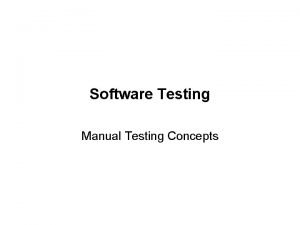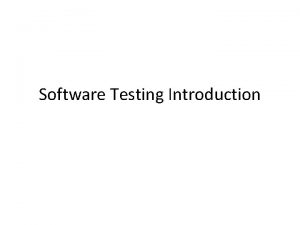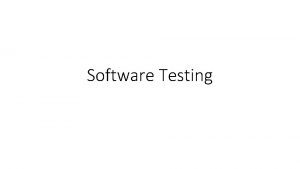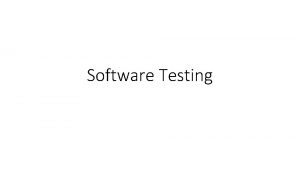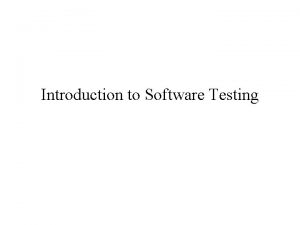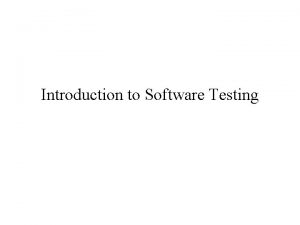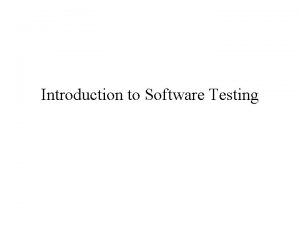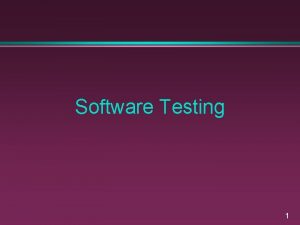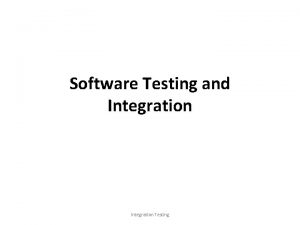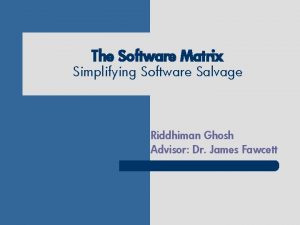Software Testing Sudipto Ghosh CS 406 Fall 99




































- Slides: 36

Software Testing Sudipto Ghosh CS 406 Fall 99 November 23, 1999 11/23/99 CS 406 Testing

Learning Objectives • • • Coverage Principle Saturation principle Mutation testing Test case generation and tool support Testing OO programs Testing distributed and real-time systems 11/23/99 CS 406 Testing 2

Principle underlying test assessment • Uniform principle that underlies test assessment throughout the testing process • Coverage Principle • Result of intensive research at Purdue and other research groups in software testing 11/23/99 CS 406 Testing 3

The coverage principle • To formulate and understand the coverage principle, we need to understand: • coverage domains • coverage elements • Coverage domain: • finite domain, related to the program under test • Coverage element: • individual elements in the domain 11/23/99 CS 406 Testing 4

The coverage principle (contd) Coverage Domains Coverage Elements Requirements Functions Statements Branches : : All uses All paths 11/23/99 CS 406 Testing 5

The coverage principle • Measuring test adequacy and improving a test set against a set of well-defined, increasingly strong, coverage domains leads to improved confidence in the reliability of the system under test. 11/23/99 CS 406 Testing 6

The coverage principle (contd) • Note the following properties of a coverage domain: • It is related to the program under test. • It it finite. • It may come from program requirements, related to the inputs and outputs. • Exercise: Give examples. • It may come from the program code. • Exercise: Give examples. • It aids in measuring test adequacy and the progress made in testing. 11/23/99 CS 406 Testing 7

Using coverage criteria • Improving coverage improves our confidence in the correct functioning of the program under test • Given a program P, and a test set T, suppose that T is adequate w. r. t. a coverage criterion C. • Does that mean that P is error free? • Obviously …? ? ? 11/23/99 CS 406 Testing 8

Test effort • Several measures available • Size of the test set T • A test set with a larger number of test cases corresponds to higher effort than one with less number of test cases 11/23/99 CS 406 Testing 9

Error detection effectiveness • Each coverage criterion has its error detection ability. • How do you measure effectiveness? 1 Fraction f of faults guaranteed to be revealed by a test T that satisfies C. 2 At least a fraction f of the faults in P will be revealed by test T that satisfies C. • No absolute measure of effectiveness of any given coverage criterion for a general class of programs and arbitrary test sets. 11/23/99 CS 406 Testing 10

Error detection effectiveness (contd) • Empirical studies conducted by researchers give us an idea of the relative goodness of various coverage criteria. • For a variety of criteria, we can make a statement like: • Criterion C 1 is definitely better than C 2. • Sometimes, we can say: • Criterion C 1 is probably better than C 2. 11/23/99 CS 406 Testing 11

Error detection effectiveness (contd) • Such information allows us to construct a hierarchy of coverage criteria • This hierarchy helps in organizing and managing testing. 11/23/99 CS 406 Testing 12

The saturation effect Rate of fault discovery • The rate at which new faults are discovered reduces as test adequacy w. r. t. a finite coverage domain increases. • The rate reduces to zero when the coverage domain is exhausted. 0 11/23/99 Coverage 1 CS 406 Testing 13

Saturation effect: Fault view N Remaining Faults M 0 t fs Functional t fe t ds tdfe t me Testing Effort 11/23/99 CS 406 Testing 14

Saturation effect: Reliability view Reliability R’d R’f Rm Rdf Rd Rf R’df R’m Mutation Dataflow Decision Functional t fs True reliability (R) Estimated reliability (R’) Saturated region t fe tds tde tdfs tdfe t ms t f e Testing Effort FUNCTIONAL, DECISION, DATAFLOW AND MUTATION COVERAGE PROVIDE VARIOUS TEST EVALUATION CRITERIA 11/23/99 CS 406 Testing 15

Mutation testing • Fundamentally different from previous approaches. 1 Take a program. 2 Create mutants by making simple changes. 3 Goal of testing is to make sure that each mutant produces an output different from the output of the original program. 11/23/99 CS 406 Testing 16

Mutant operators • Makes a small unit change in the program • • • Replace an arithmetic operator by another Replace a constant by another Change an array reference Change the label for a goto statement Replace a variable by a special value (like 0) • First-order mutant obtained by making exactly one change. • Need to model real faults. 11/23/99 CS 406 Testing 17

Basis for mutation testing • Competent programmer hypothesis • Coupling effect 11/23/99 CS 406 Testing 18

Competent programmer hypothesis • Programmers are generally competent and don’t create programs at random. • A programmer produces a program that is very close to a correct program. • A correct program can be constructed from an incorrect program with minor changes in the program. 11/23/99 CS 406 Testing 19

Coupling effect • Test cases that distinguish programs with minor differences with each other are so sensitive that they will also distinguish programs with more complex differences. 11/23/99 CS 406 Testing 20

Mutation testing • You are building up your test set T with test cases. • Generate mutants for P. Suppose that there are N mutants. • Execute each mutant and P on each test case in T. • Find how many mutants were distinguished. These mutants are called dead. Let there be D dead mutants. 11/23/99 CS 406 Testing 21

Mutation testing • For each mutant that was not distinguished (called, live), find out how many are equivalent to P, i. e. they will always produce the same output as P. Let E be the number of equivalent mutants. • The mutation score is • Add more test cases to T and continue testing until the mutation score is 1. 11/23/99 CS 406 Testing 22

Using mutation testing to improve test sets • Empirically shown to be stronger than cuses and p-uses. • Suppose that you have used some coverage criteria and you have a test set T adequate w. r. t. the criteria. • You have removed all the errors found during testing and now the program passes the tests in T. • You can use mutation testing to improve T. 11/23/99 CS 406 Testing 23

Performance • Serious problem with mutation testing • Number of mutants generated with the first -order operators is large • Fortran: For a program with L lines of code, the total number of mutants is L 2 • All have to be compiled and executed • Tester has to spend considerable time to decide if some mutants are equivalent. This is an undecidable problem. 11/23/99 CS 406 Testing 24

Test case generation and tool support • Once you have decided a coverage criterion, there are two problems: • Decide if a test set is adequate w. r. t. the criterion • Generate a set of test sets • Difficult to do both tasks manually • “Feasibility” of a path is an undecidable problem 11/23/99 CS 406 Testing 25

Test generation • Fully automated tool not possible • Tools aid the tester • Ways: • Tool randomly generates tests until the criterion is satisfied • Generates a lot of unnecessary tests 11/23/99 CS 406 Testing 26

Test generation • Testing is done manually by performing structural testing iteratively • Tools gives feedback on what paths are left • Static dataflow tools can be used to decide what input values should be given for that path to be executed • Symbolic evaluation techniques can be used • Ingenuity and creativity of the tester is important • Often the criteria is weakened (< 100%) 11/23/99 CS 406 Testing 27

Testing tools • Usual steps: • Instrument the program with probes • Execute the program with test cases • Analyze the results of the probe data 11/23/99 CS 406 Testing 28

Testing object oriented programs • Not really different if you are using blackbox testing • Why is white-box testing different for OO? • White-box likely to be at unit level. • Basic unit is “Class” • Fundamental differences between testing classes and functions • Testing methods individually and functions may be similar 11/23/99 CS 406 Testing 29

Testing OO Programs • Testing all methods separately is not same as testing the class • Class cannot be tested directly; only an instance can be tested. • How do you test abstract classes? • Control flow characterized by message passing among objects, no sequential control flow within a class like in a function • Different approach required. 11/23/99 CS 406 Testing 30

Testing OO Programs • State associated with object also influences the path of execution; methods of a class can communicate among themselves using the state. • for function, arguments and global variables determine the path of execution • Inheritance • structure of inheritance hierarchy • kind of inheritance 11/23/99 CS 406 Testing 31

Problems with inheritance • Structure (lattice or tree) • Lattice - a class at the bottom may inherit some features more than once • Classes are more complex and error-prone • Kind (strict or redefining allowed) • Dynamic binding of operations, we don’t know until run-time whether the operation is defined 11/23/99 CS 406 Testing 32

Techniques • Exercise the routines provided by an object with the goal of uncovering errors in the implementation of the routines or state of the object or both • Find patterns of method invocation of the object under test with different arguments. • State-based testing tests for interaction by changing the state of the object under which the methods are tested. 11/23/99 CS 406 Testing 33

Testing distributed software • Uniprocessor environment assumptions do not hold • • Global environment Deterministic execution Sequential execution of instructions Insertion of debugging statements do not alter execution of product • Timing-dependent faults • Need special techniques • history files 11/23/99 CS 406 Testing 34

Issues in testing real-time systems • “Real-world” inputs • No control over timing • No control over order • Similar problems as with distributed software • Often no human operators • More robustness required • high fault-tolerance • Difficulty in setting up test cases 11/23/99 CS 406 Testing 35

Testing real-time systems • • • Structure analysis Correctness proofs Systematic testing Statistical testing Simulation 11/23/99 CS 406 Testing 36
 Domain testing
Domain testing Logic based testing in software testing
Logic based testing in software testing Data flow testing strategies in software testing
Data flow testing strategies in software testing Globalization testing example
Globalization testing example What is testing
What is testing Control structure testing in software engineering
Control structure testing in software engineering Decision table testing in software testing
Decision table testing in software testing Decision table for triangle problem
Decision table for triangle problem Limited entry decision table
Limited entry decision table Rigorous testing in software testing
Rigorous testing in software testing Testing blindness in software testing
Testing blindness in software testing Software testing domains
Software testing domains Pradip dey c programming
Pradip dey c programming Responsibility for climate change
Responsibility for climate change Dr ranjan ghosh
Dr ranjan ghosh Kashiprasad ghosh
Kashiprasad ghosh Joydeep ghosh
Joydeep ghosh Urmi ghosh-dastidar
Urmi ghosh-dastidar Dibyajyoti ghosh
Dibyajyoti ghosh Advocate prodipto ghosh
Advocate prodipto ghosh Shibani ghosh
Shibani ghosh Programming in c by pradip dey
Programming in c by pradip dey Dr ranjan ghosh
Dr ranjan ghosh 406 woodruff key dimensions
406 woodruff key dimensions Despertai vos levantai vos
Despertai vos levantai vos Magisches quadrat 8x8
Magisches quadrat 8x8 Ece406
Ece406 Ece 406
Ece 406 406 afsb
406 afsb Pharm 406
Pharm 406 Multithread chain stitch
Multithread chain stitch 406 registration
406 registration Cs 406
Cs 406 Nec article 406
Nec article 406 Hisense rb 406 n 4 ac 2
Hisense rb 406 n 4 ac 2 Positive testing and negative testing
Positive testing and negative testing Static testing and dynamic testing
Static testing and dynamic testing












